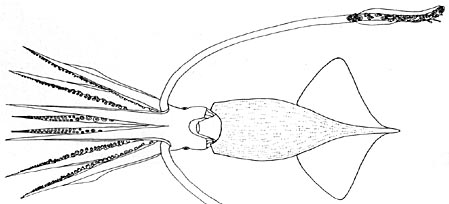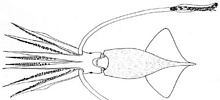Onykia lonnbergii
Michael Vecchione, Richard E. Young, and Kotaro TsuchiyaIntroduction
O. lonnbergii is one of two species of Onykia known to occur in the high North Pacific (the other is O. robusta). O. lonnbergii is the smaller of the two species reaching a length of 307 mm ML (Tsuchiya and Okutani, 1991).
Diagnosis
An Onykia ...
- with rhomboidal fin but slightly drawn-out posteriorly.
- with longitudinal ridges and warts in skin.
- with gladius rostrum having a triangular cross-section.
Characteristics
- Tentacles
- Club with 25 hooks
 image info
image info Figure. Oral view of tentacular club of O. lonnbergii, 215 mm ML, Suruga Bay, Japan. Drawing from Kubodera et al., 1998.
- Mantle
- Dermis of mantle with short longitudinal ridges and warts.
- Fins
- Fins with rhomboidal shape but drawn out somewhat into short tail.
- Width 50-55% of ML.
- Gladius
- Gladius with long rostrum; triangular in cross-section.
comments
The above description is taken from Kubodera et al. (1998). This species is very similar to O. robsoni. They differ in the cross-sectional shape of the rostrum (triangular vs oval) and the the form of the dermal skin pads (short, narrow, fusing with one another vs long and wide) (Nesis, 1982/87). Sasaki (1929) describes the warts as follows: "Warts on mantle wrinkle-like, running lengthwise, anastomosing one another by oblique branches. They measure 0.3-0.8 mm in breadth, distant from one another as far as their own breadth."
Life History
An apparently mature male with penis protruding from the funnel was reported in a 307 mm ML squid (Tsuchiya and Okutani, 1991).
Distribution
Type locality is the beach of Sagami Bay, Japan. The squid was assumed to have been discarded by fishermen (Kubodera, et al., 1998). O. lonnbergii is found in the western North Pacific and the Indian Ocean (Saya-de-Malha Bank) (Kubodera, et al., 1998).
References
Nesis, K. N. 1982/87. Abridged key to the cephalopod mollusks of the world's ocean. 385+ii pp. Light and Food Industry Publishing House, Moscow. (In Russian.). Translated into English by B. S. Levitov, ed. by L. A. Burgess (1987), Cephalopods of the world. T. F. H. Publications, Neptune City, NJ, 351pp.
Kubodera, T., U. Piatkowski, T. Okutani and M.R. Clarke. 1998. Taxonomy and Zoogeography of the Family Onychoteuthidae (Cephalopoda: Oegopsida). Smithsonian Contributions to Zoology, No. 586: 277-291.
Sasaki, M. 1929. A monograph of the dibranchiate cephalopods of the Japanese and adjacent waters. Journal of the College of Agriculture, Hokkaido Imperial University, 20(Supplementary number):1-357.
Tsuchiya, K., and T. Okutani. 1991. Growth Stages of Moroteuthis robusta (Verrill, 1881) with the Re-evaluation of the Genus. Bulletin of Marine Science, 49(1/2):137-147.
About This Page
National Marine Fisheries Service
Systematics Laboratory
National Museum of Natural History
Washington, D. C. 20560
USA
Richard E. Young
Dept of Oceanography
University of Hawaii
Honolulu, Hawaii 96822
USA
Tokyo University of Fisheries, Konan, Minato, Tokyo
Page copyright © 2003 , Richard E. Young, and
- First online 23 June 2003
Citing this page:
Vecchione, Michael, Young, Richard E., and Tsuchiya, Kotaro. 2003. Onykia lonnbergii . Version 23 June 2003 (under construction). http://tolweb.org/Onykia_lonnbergii/19974/2003.06.23 in The Tree of Life Web Project, http://tolweb.org/








